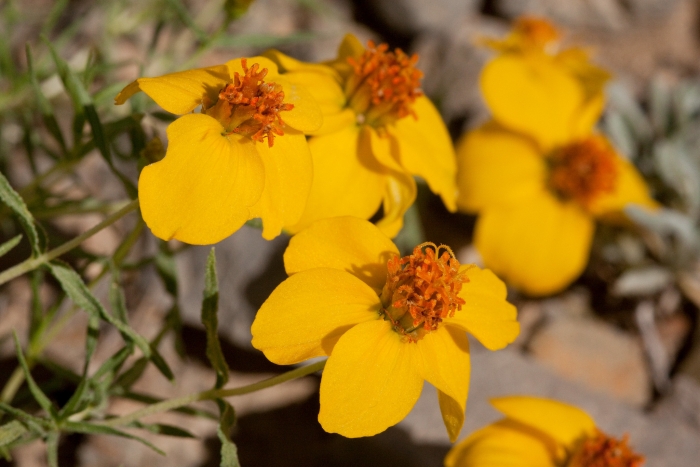Rocky Mountain Zinnia
(Zinnia grandiflora)
Rocky Mountain Zinnia (Zinnia grandiflora)
/
/

Patrick Alexander
CC0
Image By:
Patrick Alexander
Recorded By:
Copyright:
CC0
Copyright Notice:
Photo by: Patrick Alexander | License Type: CC0 | License URL: https://creativecommons.org/licenses/by-sa/4.0 | Uploader: Josve05a | Publisher: Wikimedia Commons |



















































Estimated Native Range
Summary
Zinnia grandiflora, commonly known as Rocky Mountain Zinnia, is a deciduous perennial herb native to the grasslands and semi-desert regions of the South Central and Southwestern United States, as well as Mexico. This plant typically forms a small, flat-topped or rounded mound, reaching up to 22 cm (8+1⁄2 in) in height with numerous slender, branching stems. The linear leaves are oppositely arranged, measuring 1–3 cm (1⁄2–1+1⁄4 in) in length, and are covered with short, rough hairs. The flower heads feature 3 to 6 bright yellow ray florets, each 1–2 cm (1⁄2–3⁄4 in) long, surrounding a cluster of tubular disc florets at the center. Flowering occurs from late summer to early fall, and the blooms are moderately showy, attracting pollinators such as butterflies.
Rocky Mountain Zinnia is valued for its drought tolerance and vibrant yellow flowers, which add a splash of color to xeriscapes, rock gardens, and naturalized areas. It is often used as a ground cover or for border planting in areas with poor, dry soils. This zinnia thrives in full sun to part shade and requires minimal water once established, making it an excellent choice for low-maintenance gardens. While it is generally pest-free, it can be susceptible to powdery mildew in humid conditions. To prevent this, ensure good air circulation around the plants.CC BY-SA 4.0
Rocky Mountain Zinnia is valued for its drought tolerance and vibrant yellow flowers, which add a splash of color to xeriscapes, rock gardens, and naturalized areas. It is often used as a ground cover or for border planting in areas with poor, dry soils. This zinnia thrives in full sun to part shade and requires minimal water once established, making it an excellent choice for low-maintenance gardens. While it is generally pest-free, it can be susceptible to powdery mildew in humid conditions. To prevent this, ensure good air circulation around the plants.CC BY-SA 4.0
Plant Description
- Plant Type: Herb
- Height: 0.3-0.6 feet
- Width: 1-2 feet
- Growth Rate: Moderate
- Flower Color: Yellow
- Flowering Season: Summer, Fall
- Leaf Retention: Deciduous
Growth Requirements
- Sun: Full Sun
- Water: Low
- Drainage: Fast
Common Uses
Bank Stabilization, Bee Garden, Bird Garden, Border Plant, Butterfly Garden, Deer Resistant, Drought Tolerant, Erosion Control, Groundcover, Hummingbird Garden, Low Maintenance, Potted Plant, Rabbit Resistant, Rock Garden, Salt Tolerant, Showy Flowers, Street Planting
Natural Habitat
Native to grasslands and semi-desert regions of the South Central and Southwestern United States, and Mexico
Other Names
Common Names: Texas Zinnia , Plains Zinnia
Scientific Names: Zinnia grandiflora , Crassina grandiflora
GBIF Accepted Name: Zinnia grandiflora Nutt.